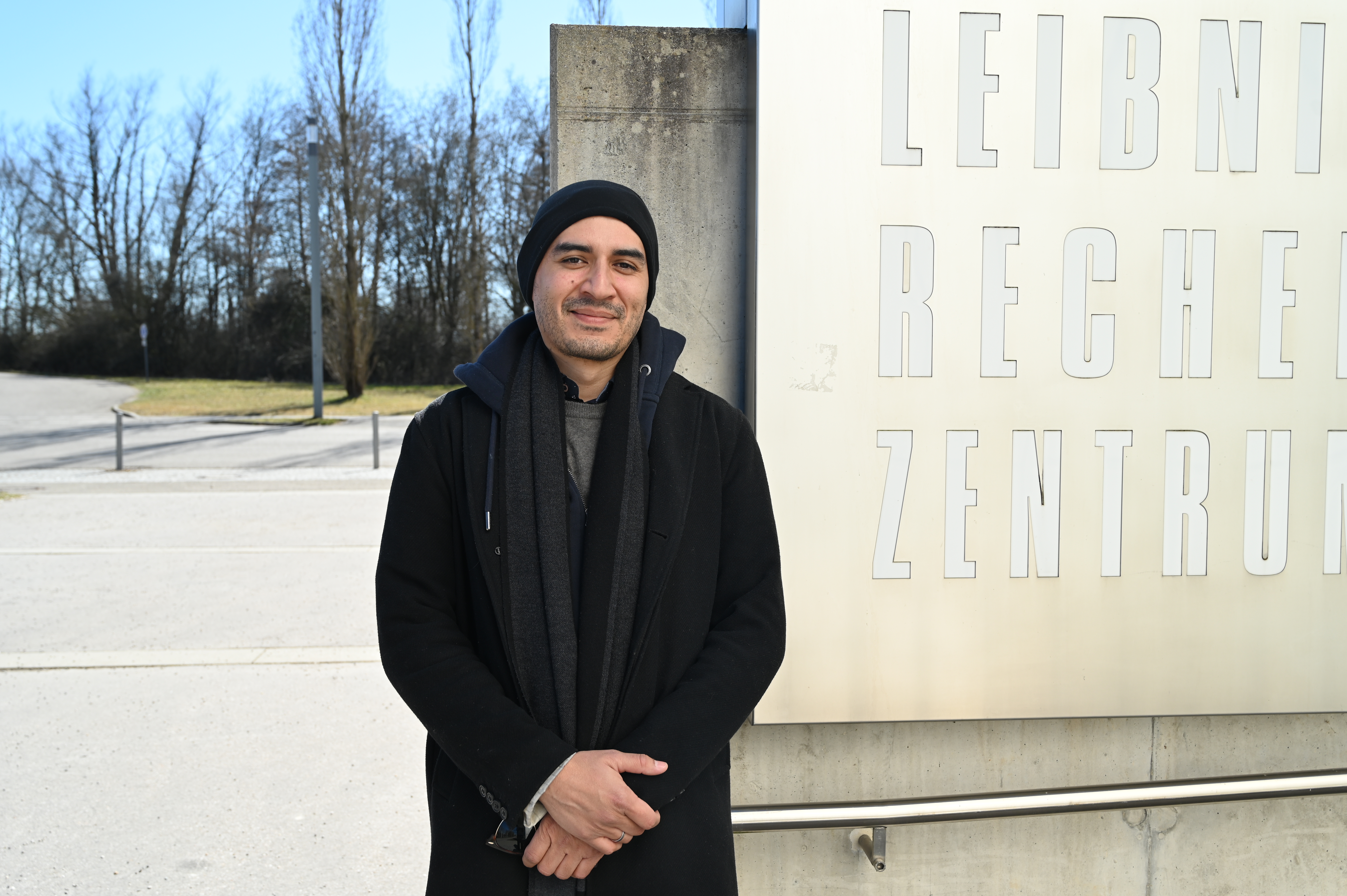“Computer science is like an onion, it has many layers”
Finding optimal ways of computing
Driven by a deep curiosity about how things work in general, Jorge Echavarria enjoys exploring the various layers of computing. In his position at the Leibniz Supercomputing Centre, he has been able to delve further into the area of quantum computing – a field that continues to amaze him.
By Veronika Früh
A bright blue sky extends over the Leibniz Supercomputing Centre (LRZ) in Garching near Munich. Despite the sun, it is still rather cold this morning in March. Too cold, if you ask Jorge Echavarria. When the scientist steps out of the building briefly for a photo, he first wraps up warmly in his jacket, scarf and hat. In the ten years he has lived here, the native of Mexico still has not become accustomed to the German winter. After completing his master's degree in computer science at the Instituto Nacional de Astrofísica, Óptica y Electrónica in Mexico, Jorge followed his academic interests and moved to Erlangen to do his doctorate at the Friedrich-Alexander-Universität (FAU). For the past two years, he has been a staff scientist at the LRZ, where he leads the 'Quantum Integration Software' group. Additionally, since 2024, he is one of the technical leaders of MQV's Munich Quantum Software Stack (MQSS).
“If I had to label my research, I would say that my focus is on multi-objective optimization problems,” says Jorge, summarizing his work since his master's degree, through his Ph.D. and up to the present day with one term – albeit a long one. The idea is to achieve several goals in a system at the same time, with the difficulty that these goals are often opposed to each other. “Maybe you want to increase the speed of your calculation, but because you increase the speed, your resource consumption also increases. And vice versa,” the scientist explains it a little more concretely. “What you want to achieve is something called Pareto optimality. This means that both goals are satisfied without having to compromise unilaterally on either of them.” It becomes even more exciting when there are more than two objectives. Then you have to evaluate not only the solution, but also the methodology for finding that solution.
In his daily work at the LRZ, this means finding methods to compile quantum circuits efficiently and execute them on the respective quantum hardware in the data center without spending too much time. In doing so, the properties of the hardware and the quantum gates that can be executed on the respective system must be taken into account. “The problem is that you might want to execute hundreds or thousands of these circuits simultaneously. So you need to solve this as fast as possible,” Jorge continues. Sometimes you can just use a supercomputer to do it – ”but there are only so many! That's why we have to think of clever solutions.”
Getting to the bottom of computing
What Jorge finds so intriguing about computer science is getting to the very bottom of computing. After school, he was torn between physics, math and, of course, computer science. In the end, computer science won him over. “I think of the field as an onion. It has different layers,” he says. The core of the computer science onion is basically mathematics, around which logic and logical statements are built, layer by layer. “And when you reach a new layer, you find other things that are exciting,” the scientist continues his metaphor. “That's what I love about computer science. It lets you do so many things on so many different levels.”
Speaking of onions: as an alternative to studying science, Jorge considered pursuing a completely different career – becoming a chef. “But I'm really not that good at cooking,” he says with a laugh. He also dismissed his childhood dream of becoming a pilot. Becoming a scientist was something he ended up doing almost by default. Going to university after school was simply the next logical step. He only came into contact with actual scientific research – reading literature and applying the knowledge in his own projects – at the end of his bachelor's degree. “At that moment, I knew that this was definitely what I liked. I knew then that I wanted to be a scientist and do research,” he recalls, looking back some 15 years.

Jorge Echavarria, 38
Position
Staff scientist
Institute
Leibniz Supercomputing Centre (BAdW)
Q-DESSI
Degree
Computer Science
Jorge is developing methods to solve quantum computing problems in a way that several goals in a system can be achieved at the same time. He is trying to find efficient and clever solutions for these so-called multi-objective optimization problems.

Solving multi-objective optimization problems
The common thread running through his scientific career since the beginning is solving multi-objective optimization problems of various kinds. In his master's thesis, for example, he dealt with the protection of intellectual property in the design of circuits. He developed a technique for inserting an author's signature at the lowest level of abstraction of the circuit. “To do that, I had to solve a multi-objective optimization problem that took place inside,” the scientist explains. “At the time, there was a group at the Polytechnic University of Valencia working on something that was roughly the solution to my problem,” he continues. They were working with something called genetic algorithms, an optimization method inspired by the process of natural selection in evolution. Jorge's specific problem was a suitable application for this: “I was already familiar with genetic algorithms, but I didn't know how exactly to encode my problem using representations inspired by natural evolution.” So he visited his Spanish colleagues as part of an academic stay.
His stay in Valencia made it clear to him that he could achieve much more by being where the latest cutting-edge technology was being developed: “Today that seems pretty obvious, but at the time it was a real eye-opener!” After completing his master's degree, Jorge was already working in a company in the field of research and development, so he decided to do his doctorate at FAU. “I thought to myself, I have to go where the real development is happening.” At the time, he was also working, ‘once again,’ as he says, on multi-objective optimization problems. ‘I knew this is what I wanted to do and that I had to find out who was really doing it,’ he says.
After completing his doctorate, the position at the LRZ was the one that best suited Jorge's interests. “One of the things I like most about my job is that you can propose solutions that you then actually see implemented,” he explains. This was one of the reasons for him to switch from pure science to research and development: “You have an idea and then you see how it is implemented. You are not only providing a service, but also making it as efficient as possible. Or you discover a solution to a problem that has not even been identified yet.”
Shifting towards quantum computing
By moving to the LRZ, Jorge also took a step towards quantum computing. He had always been interested in quantum-related topics. “It's just absolutely crazy! The whole thing is crazy,” he explains his fascination. For him, it's about understanding at the core how things work. It started with him thinking about what actually happens in the conductive paths on the computer chips he was working on. “I tried to visualize it, like with marbles, and to see how individual electrons in the cable encounter resistance and how the cable heats up as a result,” Jorge explains. Then he tried to connect the individual dots, to understand what temperature is – “just the vibrations, that makes sense” – but then? How is the energy being transferred? So he started reading texts on quantum field theory and was fascinated. “I was lucky enough to be able to start working on this with a relatively small change in my career. And also to be a bit closer to quantum computing.”
When Jorge starts talking, his thoughts often flow from one topic to the next, one thing reminds him of the other, and it shows how versatile his interests are and how enthusiastic the scientist is. “Recently, I read something...” he begins, when he is just talking about what helped him to find an approach to quantum mechanics, “I wanted to understand where magnetism comes from.” Einstein and the theory of relativity were part of the explanation. “I don't fully understand why this makes perfect sense, because I don't quite understand the math behind it,” he admits. However, the intuitive understanding of length contraction and charge imbalance came quite easily to him. You didn't have to understand every detail behind it. And that was how it was with quantum computing, he finds – “Wait, why am I telling this?” – the arc back to the beginning. And just as he, the computer scientist, could not and did not have to understand every physical detail, some of the computer science concepts were difficult for his physics colleagues to grasp.
It is precisely these different perspectives from which the same problem is viewed that Jorge finds exciting: “Some people are very good at abstracting problems. Some people can formulate an answer in a different way.” So it happens that someone explains something and uses a certain kind of notation. Someone else translates this notation into another – and then it suddenly becomes understandable for people with a different background. “I love that!” the scientist exclaims. The different perspectives are also something that Jorge greatly appreciates about Munich Quantum Valley. But back to his own perspective, that of a computer scientist. If he could wish for one thing for quantum computing, he can again answer with a single word: “Standards!”
Published 25 April 2025; Interview 18 March 2025